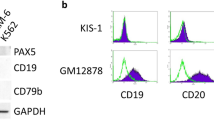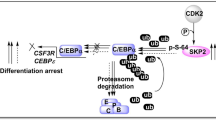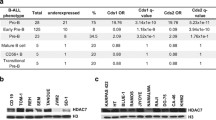Abstract
Gene aberrations of B-cell regulators and growth signal components such as the JAK–STAT pathway are frequently found in B-cell acute lymphoblastic leukemia (B-ALL). EBF1 is a B-cell regulator that regulates the expression of PAX5 and co-operates with PAX5 to regulate B-cell differentiation. Here, we analyzed the function of the fusion protein of EBF1 and JAK2, EBF1–JAK2 (E–J). E–J caused constitutive activation of JAK–STAT and MAPK pathways and induced autonomous cell growth in a cytokine-dependent cell line. E–J did not affect the transcriptional activity of EBF1 but inhibited that of PAX5. Both the physical interaction of E–J with PAX5 and kinase activity of E–J were required for E–J to inhibit PAX5 function, although the detailed mechanism of inhibition remains unclear. Importantly, gene set enrichment analysis using the results of our previous RNA-seq data of 323 primary BCR-ABL1-negative ALL samples demonstrated repression of the transcriptional target genes of PAX5 in E–J-positive ALL cells, which suggests that E–J also inhibited PAX5 function in ALL cells. Our results shed new light on the mechanisms of differentiation block by kinase fusion proteins.






Similar content being viewed by others
Data availability
The RNA-seq data analysed during the current study have been deposited in the DNA Data Bank of Japan (DDBJ) and are accessible through DDBJ accession numbers JGAS000275, JGAS000276, and JGAS000278.
References
Gilliland DG, Griffin JD. The roles of FLT3 in hematopoiesis and leukemia. Blood. 2002;100(5):1532–42. https://doi.org/10.1182/blood-2002-02-0492.
Nutt SL, Kee BL. The transcriptional regulation of B cell lineage commitment. Immunity. 2007;26(6):715–25. https://doi.org/10.1016/j.immuni.2007.05.010.
Mullighan CG, Goorha S, Radtke I, Miller CB, Coustan-Smith E, Dalton JD, et al. Genome-wide analysis of genetic alterations in acute lymphoblastic leukaemia. Nature. 2007;446(7137):758–64. https://doi.org/10.1038/nature05690.
Mullighan CG. Genome sequencing of lymphoid malignancies. Blood. 2013;122(24):3899–907. https://doi.org/10.1182/blood-2013-08-460311.
Cobaleda C, Schebesta A, Delogu A, Busslinger M. Pax5: the guardian of B cell identity and function. Nat Immunol. 2007;8(5):463–70. https://doi.org/10.1038/ni1454.
Sigvardsson M, Clark DR, Fitzsimmons D, Doyle M, Akerblad P, Breslin T, et al. Early B-cell factor, E2A, and Pax-5 cooperate to activate the early B cell-specific mb-1 promoter. Mol Cell Biol. 2002;22(24):8539–51. https://doi.org/10.1128/MCB.22.24.8539-8551.2002.
Vilagos B, Hoffmann M, Souabni A, Sun Q, Werner B, Medvedovic J, et al. Essential role of EBF1 in the generation and function of distinct mature B cell types. J Exp Med. 2012;209(4):775–92. https://doi.org/10.1084/jem.20112422.
Pongubala JM, Northrup DL, Lancki DW, Medina KL, Treiber T, Bertolino E, et al. Transcription factor EBF restricts alternative lineage options and promotes B cell fate commitment independently of Pax5. Nat Immunol. 2008;9(2):203–15. https://doi.org/10.1038/ni1555.
Yasuda T, Sanada M, Kawazu M, Kojima S, Tsuzuki S, Ueno H, et al. Two novel high-risk adult B-cell acute lymphoblastic leukemia subtypes with high expression of CDX2 and IDH1/2 mutations. Blood. 2022;139(12):1850–62. https://doi.org/10.1182/blood.2021011921.
Roberts KG, Morin RD, Zhang J, Hirst M, Zhao Y, Su X, et al. Genetic alterations activating kinase and cytokine receptor signaling in high-risk acute lymphoblastic leukemia. Cancer Cell. 2012;22(2):153–66. https://doi.org/10.1016/j.ccr.2012.06.005.
Welsh SJ, Churchman ML, Togni M, Mullighan CG, Hagman J. Deregulation of kinase signaling and lymphoid development in EBF1-PDGFRB ALL leukemogenesis. Leukemia. 2018;32(1):38–48. https://doi.org/10.1038/leu.2017.166.
Roberts KG, Yang YL, Payne-Turner D, Lin W, Files JK, Dickerson K, et al. Oncogenic role and therapeutic targeting of ABL-class and JAK-STAT activating kinase alterations in Ph-like ALL. Blood Adv. 2017;1(20):1657–71. https://doi.org/10.1182/bloodadvances.2017011296.
Kurahashi S, Hayakawa F, Miyata Y, Yasuda T, Minami Y, Tsuzuki S, et al. PAX5-PML acts as a dual dominant-negative form of both PAX5 and PML. Oncogene. 2011;30(15):1822–30. https://doi.org/10.1038/onc.2010.554.
Imoto N, Hayakawa F, Kurahashi S, Morishita T, Kojima Y, Yasuda T, et al. B Cell linker protein (BLNK) Is a selective target of repression by PAX5-PML protein in the differentiation block that leads to the development of acute lymphoblastic leukemia. J Biol Chem. 2016;291(9):4723–31. https://doi.org/10.1074/jbc.M115.637835.
Hirano D, Hayakawa F, Yasuda T, Tange N, Yamamoto H, Kojima Y, et al. Chromosomal translocation-mediated evasion from miRNA induces strong MEF2D fusion protein expression, causing inhibition of PAX5 transcriptional activity. Oncogene. 2019;38(13):2263–74. https://doi.org/10.1038/s41388-018-0573-9.
Furuhata A, Kimura A, Shide K, Shimoda K, Murakami M, Ito H, et al. p27 deregulation by Skp2 overexpression induced by the JAK2V617 mutation. Biochem Biophys Res Commun. 2009;383(4):411–6. https://doi.org/10.1016/j.bbrc.2009.04.015.
Yasuda T, Tsuzuki S, Kawazu M, Hayakawa F, Kojima S, Ueno T, et al. Recurrent DUX4 fusions in B cell acute lymphoblastic leukemia of adolescents and young adults. Nat Genet. 2016;48(5):569–74. https://doi.org/10.1038/ng.3535.
Odaira K, Yasuda T, Okada K, Shimooka T, Kojima Y, Noura M, et al. Functional inhibition of MEF2 by C/EBP is a possible mechanism of leukemia development by CEBP-IGH fusion gene. Cancer Sci. 2022. https://doi.org/10.1111/cas.15641.
Chatti K, Farrar WL, Duhe RJ. Tyrosine phosphorylation of the Janus kinase 2 activation loop is essential for a high-activity catalytic state but dispensable for a basal catalytic state. Biochemistry. 2004;43(14):4272–83. https://doi.org/10.1021/bi036109b.
Koury MJ, Koury ST, Kopsombut P, Bondurant MC. In vitro maturation of nascent reticulocytes to erythrocytes. Blood. 2005;105(5):2168–74. https://doi.org/10.1182/blood-2004-02-0616.
Merluzzi S, Moretti M, Altamura S, Zwollo P, Sigvardsson M, Vitale G, et al. CD40 stimulation induces Pax5/BSAP and EBF activation through a APE/Ref-1-dependent redox mechanism. J Biol Chem. 2004;279(3):1777–86. https://doi.org/10.1074/jbc.M305418200.
Inagaki Y, Hayakawa F, Hirano D, Kojima Y, Morishita T, Yasuda T, et al. PAX5 tyrosine phosphorylation by SYK co-operatively functions with its serine phosphorylation to cancel the PAX5-dependent repression of BLIMP1: a mechanism for antigen-triggered plasma cell differentiation. Biochem Biophys Res Commun. 2016;475(2):176–81. https://doi.org/10.1016/j.bbrc.2016.05.067.
Yasuda T, Hayakawa F, Kurahashi S, Sugimoto K, Minami Y, Tomita A, et al. B cell receptor-ERK1/2 signal cancels PAX5-dependent repression of BLIMP1 through PAX5 phosphorylation: a mechanism of antigen-triggering plasma cell differentiation. J Immunol. 2012;188(12):6127–34. https://doi.org/10.4049/jimmunol.1103039.
Subramanian A, Tamayo P, Mootha VK, Mukherjee S, Ebert BL, Gillette MA, et al. Gene set enrichment analysis: a knowledge-based approach for interpreting genome-wide expression profiles. Proc Natl Acad Sci U S A. 2005;102(43):15545–50. https://doi.org/10.1073/pnas.0506580102.
Liberzon A, Subramanian A, Pinchback R, Thorvaldsdottir H, Tamayo P, Mesirov JP. Molecular signatures database (MSigDB) 3.0. Bioinformatics. 2011;27(12):1739–40. https://doi.org/10.1093/bioinformatics/btr260.
Revilla IDR, Bilic I, Vilagos B, Tagoh H, Ebert A, Tamir IM, et al. The B-cell identity factor Pax5 regulates distinct transcriptional programmes in early and late B lymphopoiesis. EMBO J. 2012;31(14):3130–46. https://doi.org/10.1038/emboj.2012.155.
Giordanetto F, Kroemer RT. Prediction of the structure of human Janus kinase 2 (JAK2) comprising JAK homology domains 1 through 7. Protein Eng. 2002;15(9):727–37. https://doi.org/10.1093/protein/15.9.727.
Hagman J, Gutch MJ, Lin H, Grosschedl R. EBF contains a novel zinc coordination motif and multiple dimerization and transcriptional activation domains. EMBO J. 1995;14(12):2907–16. https://doi.org/10.1002/j.1460-2075.1995.tb07290.x.
Treiber N, Treiber T, Zocher G, Grosschedl R. Structure of an Ebf1:DNA complex reveals unusual DNA recognition and structural homology with Rel proteins. Genes Dev. 2010;24(20):2270–5. https://doi.org/10.1101/gad.1976610.
Eulenfeld R, Schaper F. A new mechanism for the regulation of Gab1 recruitment to the plasma membrane. J Cell Sci. 2009;122(Pt 1):55–64. https://doi.org/10.1242/jcs.037226.
Bongartz H, Hessenkemper W, Muller C, Fensky M, Fritsch J, Mandel K, et al. The multi-site docking protein Gab1 is constitutively phosphorylated independent from its recruitment to the plasma membrane in Jak2-V617F-positive cells and mediates proliferation of human erythroleukaemia cells. Cell Signal. 2017;35:37–47. https://doi.org/10.1016/j.cellsig.2017.03.021.
Wolf A, Eulenfeld R, Gabler K, Rolvering C, Haan S, Behrmann I, et al. JAK2-V617F-induced MAPK activity is regulated by PI3K and acts synergistically with PI3K on the proliferation of JAK2-V617F-positive cells. JAKSTAT. 2013;2(3):e24574. https://doi.org/10.4161/jkst.24574.
Hengartner CJ, Myer VE, Liao SM, Wilson CJ, Koh SS, Young RA. Temporal regulation of RNA polymerase II by Srb10 and Kin28 cyclin-dependent kinases. Mol Cell. 1998;2(1):43–53. https://doi.org/10.1016/s1097-2765(00)80112-4.
Dawson MA, Bannister AJ, Gottgens B, Foster SD, Bartke T, Green AR, et al. JAK2 phosphorylates histone H3Y41 and excludes HP1alpha from chromatin. Nature. 2009;461(7265):819–22. https://doi.org/10.1038/nature08448.
Roberts KG, Li Y, Payne-Turner D, Harvey RC, Yang YL, Pei D, et al. Targetable kinase-activating lesions in Ph-like acute lymphoblastic leukemia. N Engl J Med. 2014;371(11):1005–15. https://doi.org/10.1056/NEJMoa1403088.
Roberts KG, Gu Z, Payne-Turner D, McCastlain K, Harvey RC, Chen IM, et al. High frequency and poor outcome of philadelphia chromosome-like acute lymphoblastic leukemia in adults. J Clin Oncol. 2017;35(4):394–401. https://doi.org/10.1200/JCO.2016.69.0073.
Shiraz P, Payne KJ, Muffly L. The current genomic and molecular landscape of philadelphia-like acute lymphoblastic leukemia. Int J Mol Sci. 2020. https://doi.org/10.3390/ijms21062193.
Mullighan CG, Su X, Zhang J, Radtke I, Phillips LA, Miller CB, et al. Deletion of IKZF1 and prognosis in acute lymphoblastic leukemia. N Engl J Med. 2009;360(5):470–80. https://doi.org/10.1056/NEJMoa0808253.
Smeenk L, Fischer M, Jurado S, Jaritz M, Azaryan A, Werner B, et al. Molecular role of the PAX5-ETV6 oncoprotein in promoting B-cell acute lymphoblastic leukemia. EMBO J. 2017;36(6):718–35. https://doi.org/10.15252/embj.201695495.
Papathanasiou P, Perkins AC, Cobb BS, Ferrini R, Sridharan R, Hoyne GF, et al. Widespread failure of hematolymphoid differentiation caused by a recessive niche-filling allele of the Ikaros transcription factor. Immunity. 2003;19(1):131–44. https://doi.org/10.1016/s1074-7613(03)00168-7.
O’Riordan M, Grosschedl R. Coordinate regulation of B cell differentiation by the transcription factors EBF and E2A. Immunity. 1999;11(1):21–31. https://doi.org/10.1016/s1074-7613(00)80078-3.
Acknowledgements
We thank Dr. W. S. Pear and Dr. R. A. Van Etten for providing MIGRI and EcoPack, respectively. We are very grateful to all members of our laboratory for their technical assistance. This work was supported by JSPS KAKENHI Grant Numbers 18H02835, 21K19505, and 22H03102 (to F.H.); Grants for Practical Research for Innovative Cancer Control Grant Numbers JP16ck0106129, JP19ck0106331, and JP22ck0106607 (to F.H.) from Japan Agency for Medical Research and Development (AMED). We sincerely thank all for their support.
Author information
Authors and Affiliations
Contributions
FH, YK, and FK designed the research. TY, EI and MS conducted RNA-seq. YK, FK, YI, KO, CY, AM, MN, SO, ST, ST, TK, and FH performed all other experiments. IM, YM, HK, and FH collected clinical samples. All authors wrote the manuscript, have contributed significantly, and are in agreement with the content of the manuscript.
Corresponding author
Ethics declarations
Conflict of interest
No authors have potential competing interests in relation to this study. Y. Miyazaki is an associate editor of International Journal of Hematology.
Additional information
Publisher's Note
Springer Nature remains neutral with regard to jurisdictional claims in published maps and institutional affiliations.
Supplementary Information
Below is the link to the electronic supplementary material.
About this article
Cite this article
Kojima, Y., Kawashima, F., Yasuda, T. et al. EBF1–JAK2 inhibits the PAX5 function through physical interaction with PAX5 and kinase activity. Int J Hematol 118, 65–74 (2023). https://doi.org/10.1007/s12185-023-03585-z
Received:
Revised:
Accepted:
Published:
Issue Date:
DOI: https://doi.org/10.1007/s12185-023-03585-z




